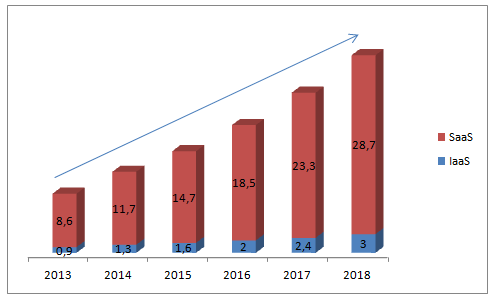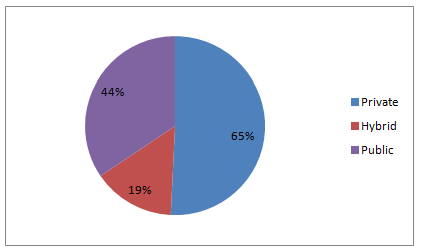АНАЛИЗ РЫНКА ОБЛАЧНЫХ ТЕХНОЛОГИЙ В РОССИИ
Кротова Е. Л. 1 Андреев Р.А. 2
1Кандидат физико-математических наук, доцент, 2ORCID:0000-0001-8875-2802 студент, Пермский национальный исследовательский политехнический университет
АНАЛИЗ РЫНКА ОБЛАЧНЫХ ТЕХНОЛОГИЙ В РОССИИ
Аннотация
В данной статье рассмотрен сегмент облачных технологий в России, и проанализированы их преимущества и недостатки.
Ключевые слова: Облачные вычисления, безопасность, SaaS, IaaS, PaaS.
Krotova E.L. 1, Andreev R.A.2
1 PhD in Physics and Mathematics, associate professor, 2 ORCID:0000-0001-8875-2802, student, Perm National Research Polytechnic University
ANALYSIS OF CLOUD COMPUTING SEGMENT IN RUSSIA
Abstract
This paper reviews segment of cloud computing in Russia, its advantages and problems.
Keywords: cloud computing, security, SaaS, IaaS, PaaS.
Nowadays cloud computing became extremely popular. They attract users with the big list of advantages such as profitability, mobility, availability and flexibility. Now the market of cloud computing in Russia is onwards and upwards. If in 2009 according to IDC agency the market size of the public cloud services in Russia was $4.8 million, then it is expected that the market size of this segment will come to more than $460 million by 2016. In general, growth of the Russian cloudy market outgrows world level, because in the conditions of crisis customers need to save money and cloud services allow them to do it. Also, popularity of clouds is caused not by only economic factors. Today people use various mobile devices – smart phones, tablet computers, laptops which allow working with information in a new way. If the company wants to provide access to corporate information systems to the employees using mobile communication channels, the easiest way is using a cloud. But what is a cloud computing? This paper reviews different classifications of cloud technologies, their advantages and disadvantages.
At first sight definition of cloud computing is very confused. Cloud computing is a model for enabling ubiquitous, convenient, on-demand access to a shared pool of configurable computing resources (for example, servers, appendices, networks, systems of storage and services) which can be quickly provided and released with the minimum efforts on management and need of interaction with provider. At the same time there are several models of cloud services. There are some of them:
Everything as a Service.
At such type of service user will have everything from firmware to management business processes, including interaction between users. User should have only access to the Internet. This type of service is more general concept in relation to those given below, which are more specific.
Security as a Service.
This type of service gives an opportunity to users quickly develop products allowing the safe using of web technologies, safety of email correspondence and also safety of local system. All of these opportunities allow users of this service saving on expansion and maintenance of their own security system.
SaaS, Software as a Service.
Software – provider applications running on cloudy infrastructure – is provided to the consumer.
PaaS, Platform as a Service.
Means for expansion of the applications developed with use of the tools and programming languages supported by provider are provided to the consumer.
IaaS, Infrastructure as a Service.
Means of data processing, storage, networks and other basic computing resources which the consumer can develop and backup any software on, including operating systems and appendices are provided to the consumer [1].
Today the SaaS services are in the greatest demand in Russia, it is connected with the client desire to maintain the systems independently that, in turn, is caused by a large number of manual created programs and the mutual suspicious of clients to the market. Conservative approach of major companies to planning their infrastructure is clear. They do not want to lose those advantages that their own unique environment gives. Therefore, they consider the possibility of obtaining turnkey computing capacities instead of services based on the certain software [2].
Fig. 1 - A market dynamic of cloud services in Russia, bln. rubles.
Now there will be considered other classification of cloud services:
The public cloud is an IT infrastructure used by many companies and services at the same time. Users of these clouds have no opportunity to operate and serve this cloud; all responsibility on these questions is attached to the owner of this cloud. Any company or an individual user can become the subscriber of the offered services. These services offer easy and affordable way of expansion of websites or business systems with great opportunities for scaling which would be inaccessible in other solutions. Examples: online services of Amazon EC2 and Simple Storage Service (S3), Google Apps/Docs, Salesforce.com, Microsoft Office Web.
The private cloud is the safe IT infrastructure controlled and operated for the benefit of the only one organization. The organization can operate a private cloud independently or charge this task to the third party contractor. The ideal private cloud is the cloud developed in the territory of the organization, served and controlled by its employees.
The hybrid cloud is the IT infrastructure using the best qualities of public and private clouds. Often such type of clouds is used when the organization has the seasonal activity cycle. As soon as the internal IT infrastructure proves unequal to current tasks, a part of capacities is thrown on a public cloud (for example, large volumes of statistical information which are not valuable for the enterprise in a raw state). However, clouds are not always public, especially in our country [2,3].
Fig.2 - Preferences of using clouds in Russia.
It does not mean that private clouds will become less. On the contrary, their number will grow as, in comparison with public clouds, they provide higher security level and allow easier integration of non-standard solutions and development of better controllability. The additional contribution creates lack of accurate regulations of work with confidential information in public clouds, for example, with private information. Now, controllers do not accurately stipulate the principles of processing of this information, and it hinders development of the market of public cloud services in the corporate environment.
To the word about a regulation: the Ministry of Communications and Mass Communications of the Russian Federation will prepare the law on using of clouds in government entities.
April 29, 2013 the Ministry of Communications and Mass Communications of the Russian Federation published the technical assignment for performance of research on the subject of "Regulatory support of availability of cloud computing for public authorities and local governments".
Growth of popularity of cloud computing technology and its advantage is noted in the document. Adoption of cloud technology by public authorities and local governments is called promising. Major limiting factor of using cloud technology in government entities is the lack of statutory regulation.
The Ministry of Communications summarizes that there is no regulatory legal act establishing the basic rules of using clouds. In this regard it is necessary to prepare offers and legal acts on using clouds in government agencies. A researcher should carry out an analysis of advantages of using cloud computing by government agencies, including austerity budget at the expense of expenditure cut on the equipment and effectivization of organization computing resources using, comparative analysis of the existing models of cloud services – SaaS, IaaS and PaaS and models of expansion of clouds – private and public, taking into account strengths and weaknesses of each of them [3].
Except that there is no document regulating usage of cloud computing in Russia there is a list of problems connected with their use.
Here only some of them:
Permanent connection with a network. It is necessary to have permanent connection with the Internet for gaining access to the cloud services. However, it is not such a great disadvantage today especially with arrival of mobile communication technologies (3G and 4G).
Software and its customization. Software which is possible to develop on "clouds" and to provide to the user is limited. The software user has no opportunity to configure software for his own purposes.
Confidentiality. In present, confidentiality of the data stored on public "clouds" causes many disputes, but in most cases experts agree that the documents most valuable to the company is not recommended to store on public "cloud" because today there is no technology which would guarantee the 100% confidentiality of the stored data.
Reliability. If you lost information stored in "cloud", you lost it forever.
Security. "Cloud" is rather reliable system, however after penetration the malefactor gets access to huge storage of data. One more minus is using systems of virtualization in which kernels of standard OS such as Linux, Windows, etc. are used as a hypervisor that allows using viruses.
According to providers of cloud services, information security in a cloud is a complex problem. Foreign vendors of information security, as a rule, do not hurry with passing through certification of Federal Service for Technical and Export Control (FSTEC) and Federal Security Service (FSB) in consequence of which their products have certain use limitations in the Russian market.
The choice of location of information systems (on the platform, in a cloud or in data processing centre of provider) depends on requirements of the client to information security. These requirements are very different and they can provide own metrics and appraisal systems. All cloud providers face similar requirements which should be considered.
Besides, information security is very conservative area; changes in this area are in process more slowly, than in IT. The new technologies and products appearing in the market are estimated by security specialists from a risk point of view, but often even distinct advantages in economic efficiency cannot move the prepossession and unavailability of information security services to follow technological trends. For large clients and systems of big scale expansion of a private cloud and existence of dedicated channel to their own office becomes a first choice. However client should resolve security and compliances issues in the same way even if servers and data are placed locally.
References
- Thomas E., Zaigham M., Ricardo P. Cloud Computing: Concepts, Technology & Architecture P. 64-66
- http://www.tadviser.ru/index.php/Статья:Облачные_сервисы_(рынок_России)
- http://www.cnews.ru/reviews/oblachnye_servisy_2013/articles/oblachnye_tehnologii_vse_eshche_v_ozhidanii_vzryvnogo_rosta


